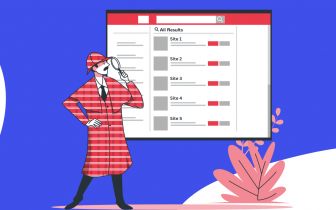How to Use Geographic Segmentation to Choose Local Guest Posting Targets

Guest posting or guest blogging is an effective way to increase online visibility, drive traffic, and build high-quality backlinks. However, its success heavily depends on the smart choice of guest posting targets.
One proven tactic involves leveraging geographic segmentation. Using smart geo targeting alongside guest posting ensures your content lands in front of the right local audience.
This combo will save you time and money and enhance content marketing results. Keep reading to learn more about geographic segmentation and how to apply it to improve your guest-posting results.
Geographic segmentation defined: Why it’s crucial for guest posting success
Location-based segmentation — often called geo segmentation — remains one of the most effective ways to target consumers. You don’t have to take our word for it; the numbers speak for themselves:
- Nine in ten marketers say location-based marketing leads to more sales.
- 83% of marketers believe geo-segmentation boosts their customer engagement.
So what are geographics in marketing, exactly? Below, we define the term and show why it’s crucial when choosing guest-posting targets.
Unpacking the definition
Let’s start simple: the geographic segmentation definition that many blogs recycle isn’t nearly as complicated as it sounds. It’s just grouping people by where they actually live rather than by age, job title, or favorite soda.
Marketers call it geo segmentation, geo targeting, or even regional targeting, depending on what slide deck they’re showing. Whatever the label, the core idea is that someone in Odessa wakes up to different realities than someone in Oslo, and your message should respect that.
Different locations create different lifestyles, and smart regional targeting takes these differences into account.
Here are a few common ways audiences vary by geography:
- City vs. suburbs
- Coastal or inland
- Hot or cold climates
- Tourist or resident
- High-income vs. low-income areas
- Commuter zones vs. remote regions
See how each point slices the world into smaller, more relatable pieces? When you zoom in like this, “Europe” suddenly breaks into micro-stories and personal buying habits.
So, geographic segmentation is about catching people where they truly are (mentally and physically), so your content feels like it was written next door. Nail that, and every guest post lands with the warmth of a local handshake instead of a billboard from abroad.
Interpreting local consumer patterns: How do marketers use geographic segmentation?
Map apps aren’t the only tools that love accurate GPS coordinates — human advertisers do too. With regional targeting, they make the difference between a simple postcode and a high-value purchase, uncovering patterns buried in plain sight.
Let’s think of lunch habits for illustration. Office hubs grab salads at 12:05, while remote valleys cook at home around 1 p.m. These are all business opportunities waiting to be explored.
Conversely, knowing which foods to avoid and where will save you from costly marketing mistakes:
Source: Business Insider
These examples represent gateways, where geo segmentation enters the stage. It converts that preference data into smarter push notifications and delivery routes.
Tellingly, every location tells a different story. Here are a few examples of how place-specific patterns shape marketing decisions:
- Office-tower density spikes orders
- School breaks boost snack sales
- Tourist zones increase weekend foot traffic
- Riverfront joggers need office lockers
- Rural roads demand sturdy delivery packaging
- Airport areas spike last-minute gift sales
In this list, each pattern speaks volumes. Layer them together, and geographical segmentation becomes a well-organized activity, a defined business process that breathes your customer map.
Results will appear in metrics that matter: lower ad spend wastage, higher repeat orders, friendlier reviews, and customers that remain loyal for a longer time, and in harder circumstances. All because geo targeting met people where they already stand, both figuratively and literally.
Benefits of geo-targeted guest posting campaigns
If your content marketing still feels impersonal, it’s because geo segmentation hasn’t joined the party. Anchoring stories to weather reports and nearby landmarks makes advice land like a friendly call, not a broadcast radio program.
It’s time to remove any remaining doubts about the efficacy of regional targeting in guest posting campaigns. For that, we’ve prepared a succinct list of the eight core benefits of marrying these two marketing techniques:
- Better local audience reach
- Higher trust and engagement
- Local SEO signals become stronger
- Bounce rates drop sharply
- Backlinks gain local authority
- Improves outreach budget allocation
- Partners with local influencers
- Better conversion efficiency
Notice how one benefit feeds the next. When content feels like home, people linger, share, and link without prompting. Nevertheless, this list is not exhaustive. You may find other benefits specific to your business type and scope of operations.
For instance, many agree that regional targeting also filters out wasted effort. Instead of pitching every blog under the sun, marketers target the sites where their highest-value and most engaged audience resides.
Less scatter, more focus — that’s the simple math behind better returns. Each local win builds confidence to repeat the play, and soon you’re the go-to voice for that corner of the map.
That’s why geographics in marketing are only growing stronger with time and new tech. By shrinking the mental distance between tip and action, regional targeting turns curiosity into clicks.
Location-based segmentation variables
Before you dive into data gathering or copywriting, hit pause and define geographic segmentation to yourself: grouping people by the ground beneath their feet. Sounds obvious, but the magic hides in which traits you tag and track.
Source: Yieldify
Classic demographics tell you “who.” Geo targeting tells you “where” plus a hint of “why now.” Think of variables as street signs that guide your content schedule, product mix, and even the jokes you crack in an opening line.
- Weather swings (the “why now” aspect)
- City versus suburb (e.g., the suburban audience is commute topic sensitive)
- Coast versus inland (the inland audience is less concerned about beachwear trends)
- Tourist seasons (e.g, summer and winter in Zion National Park)
- Altitude level (e.g., for growing coffee beans, teas, etc.)
- Local sports playoffs (did you miss the heat of the latest Champions League in Munich?)
These markers let geo segmentation turn data into daylight-saving emails or rain-ready product bundles. When you respect local realities, your call-to-action feels timely instead of pushy.
Gather a short list, test, refine, and soon your guest posting campaigns hit like well-timed advice from a friend.
Location-focused research: From data gathering to analysis
In light of geo-targeted guest blogging, the key to geographic segmentation is the quality of information about customer geographic distribution. However, to arrive at quality information, you must first collect accurate and relevant data and perform the required analysis.

Key sources and tools for area-focused segmentation
Knowing where people actually live, shop, and scroll is the heartbeat of regional targeting. Without trustworthy inputs, even the best copy swings in the dark. So, start with data that paints a street-level portrait.
For geo segmentation, raw numbers can come from both public records and your own or corporate metrics. Government portals give the broad strokes; first-party analytics add the necessary details and depth.
Your go-to data sources are:
- Census and statistics portals
- Point-of-sale location logs
- Mobile device foot-traffic feeds
- Weather and climate archives
- Social-media check-in maps
Blend those data streams, and patterns begin to glow, like which neighborhoods binge late-night snacks or which coastlines spike sunscreen orders in April (all coastlines demand sunscreens, but a Northern area would need a higher SPF value than a Southern one).
Next, let’s talk about tech. You don’t need a NASA-level budget; you just need dashboards that crunch and visualize the basics.
Some widely accessible geo-targeting analysis tools include:
- Google Analytics location reports
- Meta Ads Audience Insights
- Foursquare foot-traffic trends
- Tableau geospatial heat maps
- SEMrush local keyword gaps
And again, you don’t need to use all these tools, certainly not at once. Pair just a few of them, and observe zip codes light up like constellations. The difference is like between a naked eye and a decent pair of binoculars, say Nikon Monarch version 5 and above.
That clarity tells you which regional blogs deserve a guest post pitch and which can wait.
Remember, the goal isn’t collecting more numbers and getting overwhelmed with data — it’s spotting the right cues. When your content echoes the local weather or commute, readers feel the message came from a neighbor, not a megaphone.
Finding and qualifying local guest posting targets
Local guest posting succeeds when you literally blend your detective instincts with genuine curiosity. Approach this work incrementally, step-by-step:
Step 1. Discover targets
Open up a geo segmentation map and zoom until you see micro-hubs — maybe a neighborhood food blog or a local dog-walking forum. These smaller audiences will guide your site search, as often they cheer the loudest when you deliver to them what they are looking for here and now.
Step 2. Verify quality
Go for it, but don’t jump in blind. Scroll down the blog’s front page and check the basics: lively headlines, recent posts, comments that don’t look like spambots.
If things look sleepy, move on. A quick search for geographics definition marketing will back you up — lively conversation beats raw page counts in every credible study.
Step 3. Assess fit
Now, test for fit. A site that dishes out subway-commute hacks isn’t the place for road-trip gear (unless you spin it right). Mirror the reader’s daily grind in your email so it feels bespoke, not broadcast.
Step 4. Craft pitch
Time for targeted communication. Open your pitch with a nugget only locals know — say, that beloved taco truck selling out by 2 p.m. most days. Editors love proof you’ve walked their streets.
If the first email doesn’t bring the desired outcome, nudge politely after a few days; simple respect and persistence can do miracles.
Pro tip
Use the guest posting service to find fitting sites faster. You will not only access domains, ready to place your guest content without any pitches, but also find some helpful features.
For instance, Adsy offers 20+ handy filters to find your best match. Apply Country and Language filters to find local geographic targets in minutes.
KPIs and metrics for geo-segmented guest posts
You’ve landed your article on that neighborhood blog — great. Now you need proof it’s working.
The first rule of regional targeting is to measure what happens in the region, not just overall. So slice your analytics dashboard by city, district, or even postal code before you move on with pitching and copywriting.
Below are the bread-and-butter numbers most marketers track for geo segmentation campaigns:
- Local referral traffic – clicks coming from the guest site’s postcode.
- On-page time by region – minutes spent reading, broken down by city.
- Backlink quality – domain authority plus regional relevance.
- Bounce rate for local visitors – do locals stick around or bail?
- Conversions by location – sign-ups or sales traced to that area.
Check these weekly for the first month. If local clicks rise but time-on-page drops, your headline worked; the article didn’t. Tweak content tone or internal links and track the above-mentioned KPIs again.
Oftentimes, the slightest change of a tone of voice, or an addition of original research and sharing interesting infographics, can drastically improve on-page time and boost referral traffic.
Finally, keep an eye on brand mentions in community forums or Facebook groups. Sometimes the best metric is a resident saying, “Hey, I saw your piece on our town blog!” That kind of buzz never fits neatly in a spreadsheet, yet it’s often the earliest sign you hit the mark.
Crafting geo-targeted guest post content
Crafting content for regional audiences requires specific skills and knowledge, and it’s a separate kind of art. The main task and the challenge are to implement the market insights obtained at the geo segmentation stage and convert them into value-packed lines that resonate with the audience.
Leveraging local insights for guest blogging
When you need to write and sign a postcard, the approach, style, and form of your copy will not be the same as when writing a press release. That mindset adaptation is at the heart of leveraging local insights. Regional targeting tells you which stamp should go on the postcard — be it coastal blue or desert orange.
Say you’re covering energy-saving tips. A geographic target market example might compare high-altitude homes needing extra insulation to muggy bay houses craving ventilation.
Readers instantly place themselves in the story, when and if you can adjust your writing style to honor local specifics:
- Call out peak season
- Acknowledge the local weather
- Name a hidden gem
- Use native expressions
- Respect the local daily rhythm
Those bite-size cues show attentive listening. Geo segmentation isn’t fancy jargon; it’s about noticing when a town’s main street shuts for a taco festival or when school breaks push traffic later.
Pepper your guest post with one hyper-local stat — maybe how last July’s heatwave spiked ice-cream sales by 18%. Stats with street-level flavor beat abstract percentages every time.
Wrap up by offering a tip that respects that reality, and you’ll come off as a helpful neighbor rather than an outside expert with a supercilious rebuke.
How to discover local keywords and vernacular
Every region has its own vocabulary and even pronunciation. Luckily, in the 21st century, you don’t need to live among the locals for years to document these peculiarities. Just a handful of modern tools and online hangouts can help you unearth local lingo quickly.
For example, take Google Trends, which shows rising keywords by city or region. Type in a broad term and switch to the “interest by subregion” view to see where certain slang or phrases pop up.
Source: Wordstream
There’s a difference between knowing a trend and knowing a town. Tools like Content Explorer put you on the ground digitally by showing the exact phrases residents type after dinner: “brew” replaces “beer,” “metro” beats “subway.”
Note those nuances carefully alongside the dates they spike, as timing is always a part of the story.
After mining search data, step into community Facebook groups or neighborhood Reddit pages. Locals trade nicknames like hard currency — “roundies” for roundabouts or “the banks” for their river walk. Drop just one of these into your intro, and it’s as if you share their daily commute.
When you weave these discoveries back into your geographic segmentation and regional targeting strategy, the content reads less like marketing and more like friendly advice passed over the fence.
Optimizing content for local search visibility
Once you’ve done collecting the local keywords (both short and long form types for more natural mobile optimization), it’s time to implement your findings.
Search visibility at the city block level comes down to matching words with surroundings. Done right, geo targeting can turn a single blog post into the go-to answer for anyone within a few miles of your targeted town’s main street.
Follow this compact roadmap:
- Kick off your content creation with a high-intent location keyword.
- Add alt text to images using street names or neighborhood nicknames for flavor.
- Insert a “Nearby attractions” list linking to authoritative local resources and guides.
- Mention seasonal events (e.g., farmers’ markets or festivals) to catch timely search queries.
- Link to the city’s official event calendar, so Google sees topical alignment.
- Embed a short list of local hashtags readers might share on social platforms.
- Provide walking, biking, and bus directions to help mobile users on the go.
- Wrap up with a quick Q&A answering three common local questions.
Consistency matters most; do this for every post tied to that city. Over time, geo segmentation signals stack up, and your domain becomes the de facto answer box for local queries.
Best of all, readers feel you’ve lived their daily routine, which wins trust that algorithms can’t fake.
Geographic market segmentation examples: Local outreach success stories
Below are three local outreach success stories that only worked because of intentional geo-targeting. Each case represents a distinct and unique challenge, solution, and outcome.
1. Explore Asheville tourism board – “Wellness in the Blue Ridge”
The challenge
Post-pandemic, Asheville needed to reignite winter tourism without blanket national ads. Locals wanted high-value visitors; the bureau needed storytelling that felt authentic.
The solution
The in-house marketers invited wellness travel blogger Allison Anderson to craft a long-form guest piece, plus reels and stories about salt-cave therapy, forest bathing, and farm-to-table dining.
The bureau covered trip costs but let her blog in her own voice, a fresh spin on outreach rooted in regional targeting rather than mass promotion.
The results
Anderson’s post and video reached 876,000 subscribers and 4,300 engagements in one week. Hotel partners logged a 12% uptick in winter mid-week bookings traced to her referral codes.
For the bureau, it was proof that influencer guest content can be a high-ROI piece of geographics examples, especially when every photo features the Blue Ridge skyline.
Source: Avlwatchdog
2. CTaxi Lebanon – “From zero to Beirut hero”
The challenge
A new ride-hailing startup in Beirut had no rankings for “airport taxi Zahle” or “safe taxi Bekaa.” Without brand recognition, tourists defaulted to global apps.
The solution
Joining forces with their client, SAG IPL agency created city-specific landing pages and placed several guest posts on travel and expat blogs (“Beirut Taxi Fare Guide 2025,” “Day Trips from Zahle Without a Car”).
Each post answered hyper-local questions and pointed to the matching booking page — one of several examples of geographic segmentation in the campaign.
The results
In eight weeks, CTaxi snagged top-10 spots for 16 location keywords, organic traffic jumped 70%, and bookings via WhatsApp tripled. Tourists praised the blog tips in reviews, turning free content into meter-running revenue.
Source: SAGipl
The case studies' key takeaways
From Asheville’s forest-bathing retreats to LA’s hidden B-roll vantage points to Beirut’s Zahle taxi routes, each of these campaigns thrived because of deliberate guest posting backed by geographic segmentation.
By leaning into exactly what locals and visitors search for (i.e., wellness weekends in the Blue Ridge, best filming spots in DTLA, or safe airport transfers in Lebanon), these teams joined forces with professional marketing agencies to turn content into conversions.
The morale? When your guest posts are rooted in place-aware insights, you don’t just reach an audience; you invite them in as if they’re chatting with a neighbor.
Geographical marketing trends: the future of localized content outreach
The power and the curse of modern marketing is that it never stops developing and becoming more and more exquisite. For those who keep track of the latest geographical marketing trends and enjoy continuous learning, it represents immense opportunities.
This chapter is meant to keep you informed about the key development trends in the localized content outreach and prepare you for what’s coming next.
AI-powered location personalization and dynamic content
AI adoption isn’t inching forward; it’s sprinting. A 2024 SurveyMonkey study found 88% of marketers already rely on AI daily, most often for tailoring messages to individual users.
The reason is clear: cutting-edge AI is now virtually ubiquitous. As shown in the graph below, leading AI supercomputers now run about two-and-a-half times faster annually than they did in 2019.
Source: Epoch AI
McKinsey adds that 71% of consumers now expect personalized interactions and get frustrated when brands miss the mark.
That hunger for relevance has pushed geo-targeting into a new era. Modern AI-powered content engines don’t just swap a city name in a headline; they can effortlessly rebuild whole sections of a page on the fly. As a result, a visitor in Phoenix sees heat-resistant paint tips, while someone two states north gets snow-proofing advice.
To a marketer some 20 years ago, it would seem like magic. Yet, for us modern content marketers, this is the normal empowerment that AI gives to everyone willing to make a small effort to learn and adopt new tools.
It’s now routine to see things such as:
- Weather-aware product banners
- Neighborhood event call-outs
- Dialect-specific headline tweaks
- Real-time store-stock alerts
- Route-based delivery ETAs
Behind the curtain, language models score local keywords, feed them into design blocks, and serve up content that feels handcrafted. Marketers set guardrails — preferred tone, compliance rules — then let algorithms remix copy and visuals for each ZIP code.
The payoff is twofold: humans feel seen, and brands waste fewer impressions. With regional targeting plus AI, personalization finally scales without copy-pasting volumes of text by hand.
Voice search’s impact on local search queries
Voice search has also moved from novelty to habit. A recent Business Wire consumer survey reports that 81% of Americans now use voice tech daily or weekly, while “near me” queries are its fastest-growing slice.
Tellingly, voice requests in 2025 read like full sentences: “Where’s the closest vegan bakery open now?” — not just “vegan bakery downtown”, as in 2020.
Longer phrasing changes how we plan content. Instead of stuffing one-word keywords, marketers weave in question-and-answer blocks that match real speech. Local pages shine when they answer who, what, when, and — most urgently — how late the shop stays open.
Here are five quick, low-tech tweaks that instantly make your guest posts and web pages friendlier to voice assistants:
- Claim and polish business listings
- Add voice-friendly FAQ snippets
- Keep opening hours up-to-date
- Sprinkle natural question phrases
- Compress images for fast loading
Speed matters because many voice searches happen on mobile data. If a page drags, assistants move to the next result without apology. Clear directions and spoken-friendly meta descriptions also help devices read answers aloud.
Finally, think of geo-tuned guest content as a verbal business card. When assistants recite your snippet, you claim both the ranking and the conversation. That’s the payoff for weaving exact locations into every outreach pitch.
Spatial analytics driving content planning and distribution
Content marketing will never be the same. Essentially, we’re all publishers with GPS now. Heat maps show exactly where yesterday’s post took off, often in places you never targeted. That surprise is the starting gun for smarter planning.
Maybe your sustainability blog post catches fire in college towns. The map flags Madison, Boulder, and Ithaca as bright orange. Next month, you commission campus guest writers and time releases around Earth Day events. This loop turns raw clicks into on-ground relevance — a marriage of spatial analytics and geographic segmentation.
Spatial analytics is just data viewed on a map. Instead of scrolling through spreadsheets, you plot clicks, shares, or sales by location and let the clusters tell their story. The moment you see where attention concentrates (or disappears), you know exactly where to aim your next headline.
Distribution becomes equally precise then. Rather than one newsletter, you create micro-segments — city coaches get coaching tips, lakefront owners receive dock-repair alerts. Done right, readers feel your brand lives on their street.
Spatial analytics isn’t about obsessing over every pixel; it’s about letting the map suggest your next move. Follow those hints, keep refining, and your content will feel less like a broadcast and more like a well-timed local conversation.
Conclusion
Content marketers and planners now use smart SEO tools and platforms to help them choose guest posting targets. Add geographic segmentation to the mix, and your targeting becomes both smarter and faster.
However, you shouldn’t view geographic segmentation as an extra step; take it as a multiplier. The moment you see that Hillsboro readers favor weekend posts or that downtown Houston clicks spike at 6 p.m., your outreach stops guessing.
You align timing, tone, and even internal links to fit the street, not the state or the American continent.
Below is a quick checklist — seven ideas you can implement next time you build a local guest-posting plan:
- Start each brief with a location keyword
- Harvest vernacular from local chats and threads
- Insert micro-FAQs that voice devices can digest and recite
- Attach driving or transit details to your links with offers
- Track bounce and dwell by neighborhood clusters
- Rewrite CTAs with street-level context and urgency
- Measure conversions on a per-ZIP basis
If these steps feel small, remember: small makes content sound personal, and accuracy builds trust faster than volume.
In addition, learn to enjoy watching the latest tech trends, both content marketing and related to guest posting. For instance, in this article, we’ve shown that AI is driving most advancements in these fields, and the transformation looks a lot more like revolutionary than evolutionary.
Specifically, these three trends are shaping the tomorrow of geo-targeted guest posting:
- AI tools are rebuilding pages city by city, and machine-learning copy that adapts per neighborhood.
- Voice search rewriting “near me” intent rules and upping conversational keyword value.
- Spatial analytics reveal untapped micro-markets, providing dashboards that can flag underserved areas down to the level of streets and neighborhoods.
Watch those currents, as well as dozens of others popping up weekly like mushrooms after a fall’s heavy rain, and your next guest post won’t just rank — it’ll resonate with your target audience’s immediate interests and needs.







